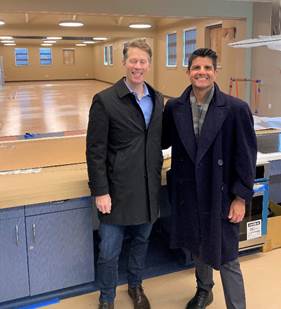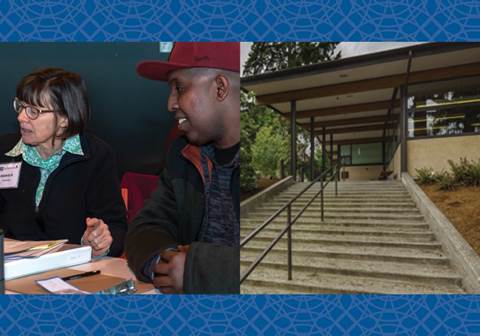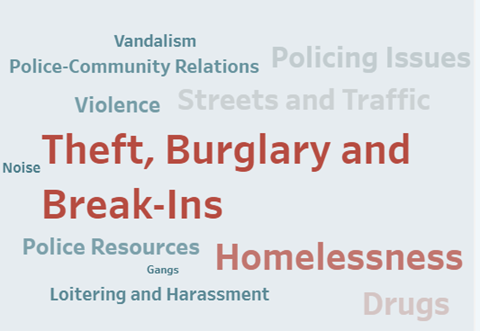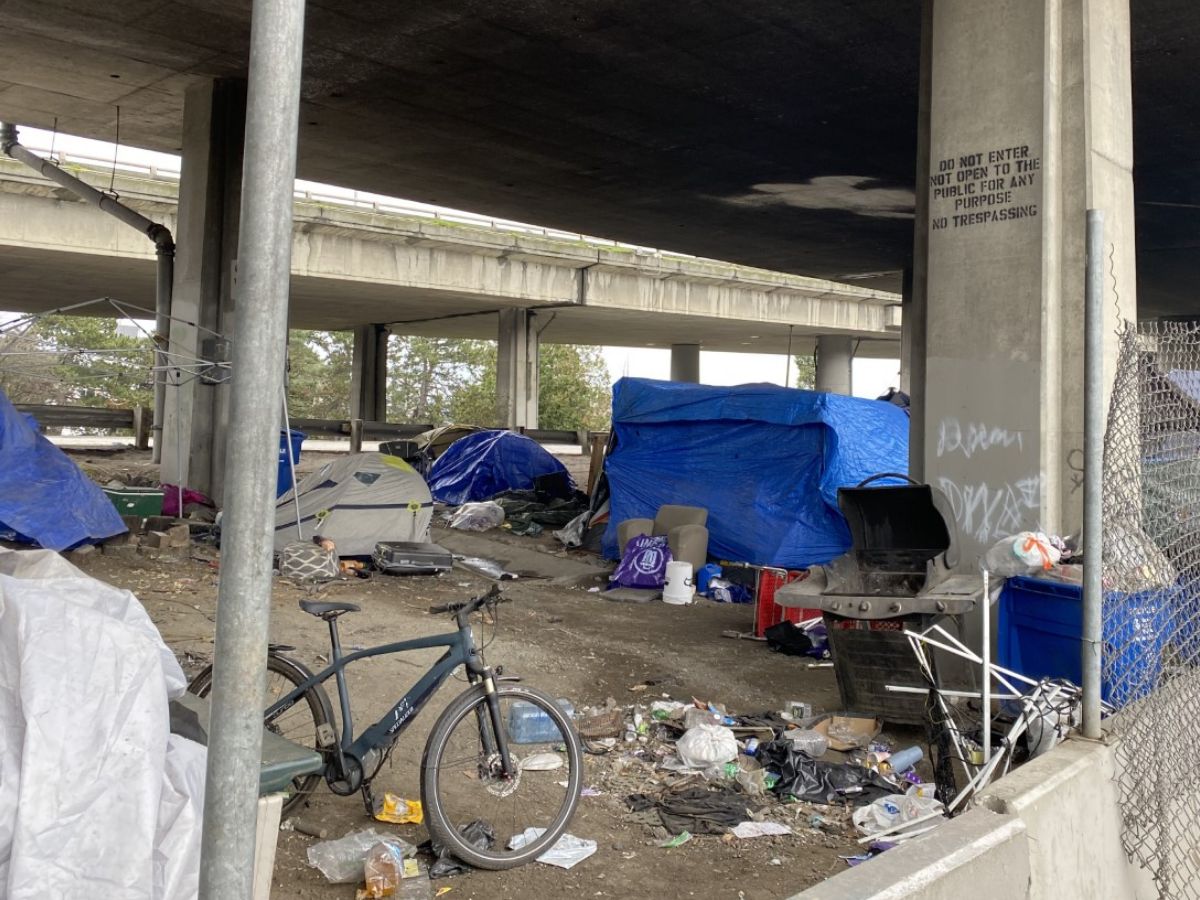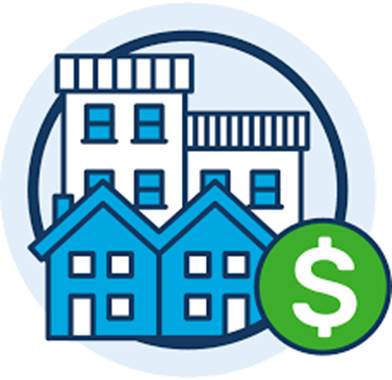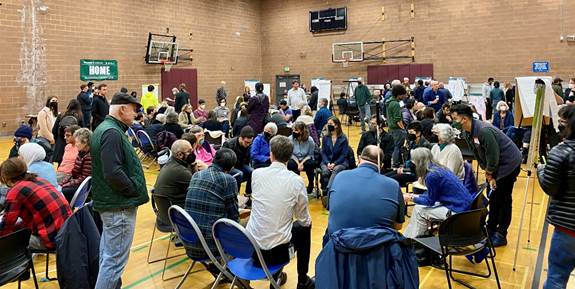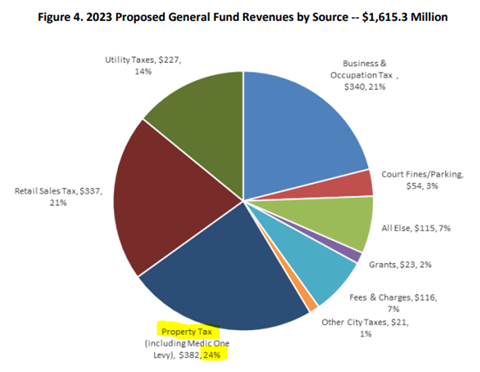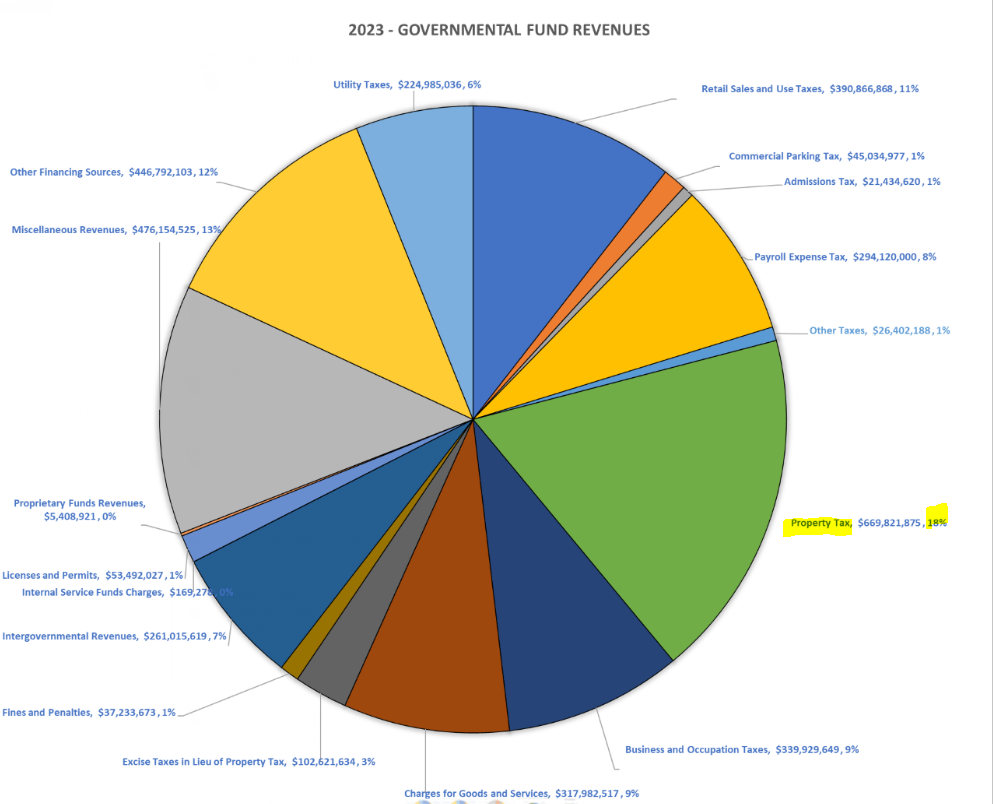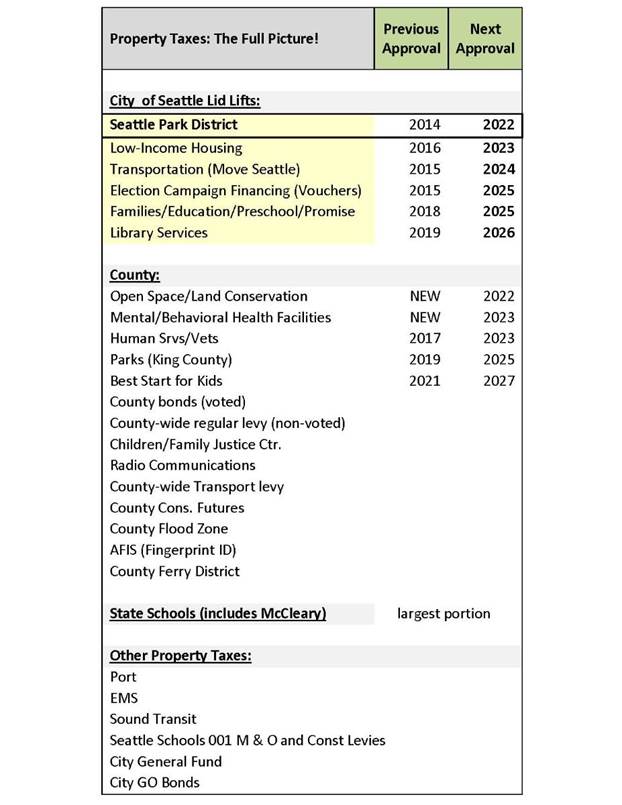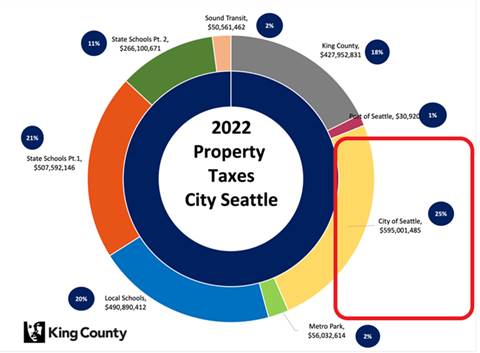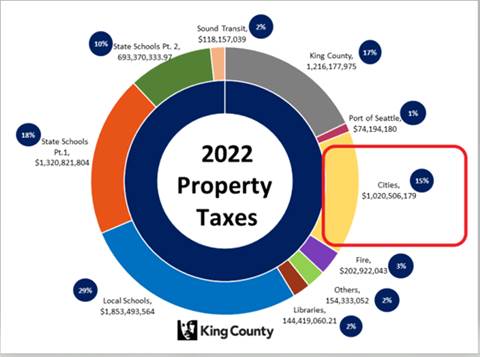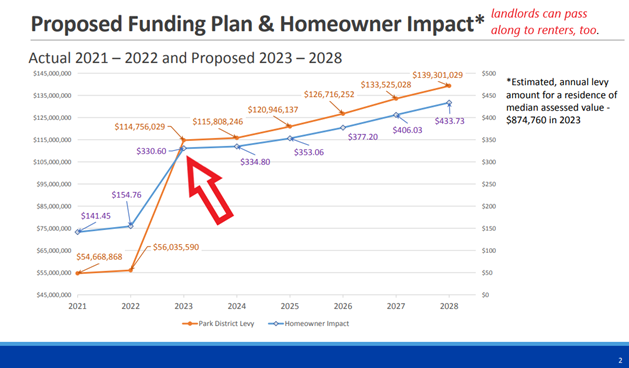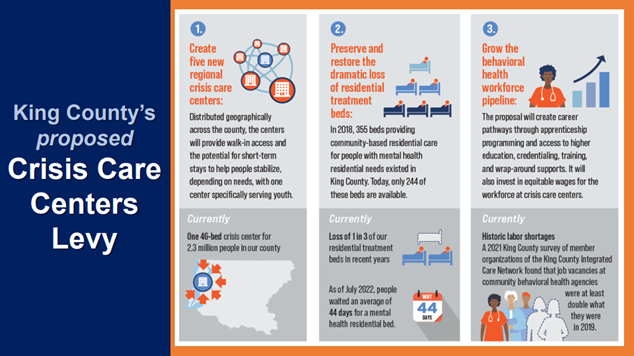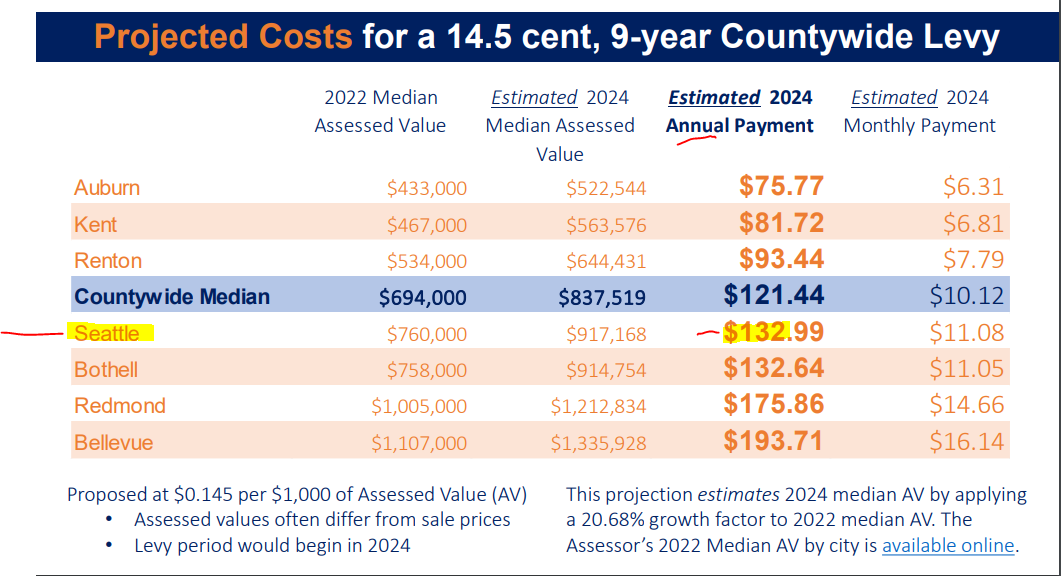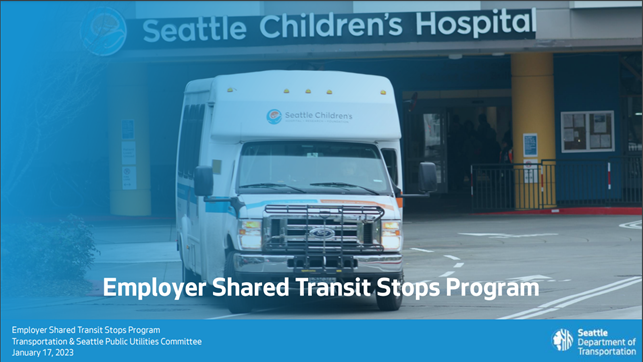So Much To Accomplish in 2023!
Friends and Neighbors,
Our first newsletter of the new year is lengthy because there’s a lot City Hall needs to accomplish in 2023. Based on feedback from constituents, I believe local government must do much more to improve safety. With its existing $250 million budget, the King County Regional Homelessness Authority (KCHRA) needs to increase the pace of sheltering people suffering from substance use disorder in unsafe conditions outside. Because so many trained officers have departed our Seattle Police Department (SPD), we need to increase the pace of hiring more detectives and community policing officers. Our city’s executive leadership needs to finally deploy effective alternative responses to some 911 calls, as well as provide more technology and facilities to take the pressure off our understaffed first responders. SDOT needs to increase pedestrian safety with additional tools proven to work in other cities and to increase bridge safety by implementing the recommendations of our City Auditor.
Earlier this month, I announced I’m not running for reelection. Being liberated from campaigning will allow more time to focus on you and your community for the rest of 2023. (For that announcement, CLICK HERE.)
Please click on the links below to zip to the sections that interest you the most:
- District 4: Engaging in Bryant, Eastlake, Magnuson Park, U District, View Ridge, Wallingford, and more.
- Public Safety and Homelessness: Crime stats – better or worse? Violent tragedy at another encampment. Shortcomings of Regional Homelessness Authority’s 5-Year Plan. Update on Tent City 3.
- Land Use Policies Impacting Seattle: Reasons to reject or amend statewide bill (HB 1110/SB 5190) so that we increase low-income housing and reduce giveaways to townhome developers. Opportunities to comment on our local comprehensive planning.
- Property Tax Increases: More transparency needed on property tax increases. Advocates propose tripling the Seattle Housing Levy property tax.
- Transportation & Seattle Public Utilities Committee: Prepared for flooding. Input for Seattle Transportation Plan. Shared Transit Stop Success. Levy Oversight Committee openings. Increasing digital equity with mapping.
- Providing Input
For my previous newsletters, you can CLICK HERE to visit my website / blog. Thank you for caring enough to demand the best from City Hall.
Before we start the traditional newsletter, it’s important to acknowledge the horrible event that occurred in Memphis, Tennessee…
BRUTALITY IN MEMPHIS, TENNESSEE:
News reports confirmed 29-year old Tyre Nichols died in the hospital on January 10, 2023, in Memphis, Tennessee, after brutal assaults and beatings on January 7 by five police officers captured on horrific video in that southern city. The Memphis officers were quickly fired and now face murder charges. On January 26, 2023, President Joe Biden said, in part, “Jill and I extend our heartfelt condolences to the family of Tyre Nichols and the entire Memphis community. Tyre’s family deserves a swift, full, and transparent investigation into his death.” For President Biden’s full statement on the horrible death of Tyre, CLICK HERE.
In solidarity with other city officials, I stand with our Mayor Bruce Harrell, who said, “The appalling, egregious, heinous beating death of Tyre Nichols is devastating – for his family, for his community, and for all of us. Unconscionable violence has no role in policing and is in direct opposition to keeping people safe. This is the kind of event that compromises and erodes trust in law enforcement not just in Memphis, but in cities and communities across the country. While the officers responsible have been terminated and charged, additional investigations and actions must create further accountability. Proactive, preventative measures, like those we have pioneered in Seattle, must be at the forefront of reform, not an afterthought when tragedies like this occur. I am proud that our Seattle Police Officers have openly rejected this injustice and violence. We feel for Tyre’s family and for the people of Memphis, and we are committed to ensuring something like this does not happen in Seattle…”
- For Mayor Harrell’s full statement from January 28, 2023, and for similar statements from our City Council President and other city leaders, CLICK HERE.
- For news coverage of this unacceptable tragedy from the Seattle Times, CLICK HERE.
- For tips on how to talk with children about traumatic incidents, CLICK HERE.
DISTRICT 4
Magnuson Park Community Center: this is the year, finally!
When new Parks Superintendent AP Diaz graciously asked where in District 4 I wanted to meet him for the first time, my answer was immediate: the community center at Magnuson Park. At long last, the light renovations inside that community center are wrapping up after delays due to COVID and other derailments. I am grateful to Superintendent Diaz immediately for recognizing the importance of that community center situated adjacent to 850 low-income neighbors who reside at the housing provided by nonprofits Mercy Housing, Solid Ground, and (soon) the Low Income Housing Institute. Superintendent Diaz was also helpful in refining some plans within Magnuson Park to discourage drag racing instigated by people outside the area.
Councilmember Pedersen, grateful for new Parks Superintendent AP Diaz, closes his eyes to make a wish for the community center at Magnuson Park to open sooner. Check out that new community space in the background! Anyone else hoping for disco dance lessons there?
Redux photo with eyes open, thanks to caffeine from Starbucks near City Hall. I appreciate the care for Magnuson Park residents already demonstrated by our new Parks Superintendent AP Diaz.
Pedestrian Safety near Elementary Schools
Standing near View Ridge Elementary School, a delighted community council leader who encouraged neighbors and the PTA to push for additional safety signage near crosswalks for the young students.
Our Seattle Department of Transportation (SDOT) has been working hard to install crosswalks, flashing warning lights, stop signs, bulb-out curbs at intersections, and other pedestrian safety projects throughout our city. Safety around neighborhoods schools is vital, which is why I worked with colleagues to push for more speed zone enforcement cameras. In View Ridge (photo above), SDOT recently installed some warning lights for a hard-to-see crosswalk used heavily by school children. It helped to have vocal community leaders who studied the intersection themselves and advocated for years. It should not have to be so difficult or take so long.
I have asked SDOT to attend a meeting of our Transportation & Seattle Public Utilities Committee as soon as possible for an analysis of traffic-related fatalities and serious injuries and for ways to improve the Vision Zero safety program that is aimed at preventing such harm. Similar to previous years, in 2022, the traffic-related fatalities were 57% pedestrians, 29% drivers, 10% cyclists, and 4% scooters — with each of these 28 fatalities being a tragedy. I’m heartened that the new SDOT Director Greg Spotts has made safety a priority, with an emphasis in south Seattle where most collisions have occurred. A new $25 million “Safe Streets” grant received on January 30 from the U.S. Department of Transportation will help!
For a Seattle Times article on this statewide problem of higher traffic-related deaths in Washington State, CLICK HERE.
An Uplifting Update from Historic U Heights Community Building
Update from U Heights Center in the heart of the U District (that big building next to the Saturday morning Farmers Market): “The construction crew has been building out the rough framing (the basic support and shape of a structure) for the hoist-way (the place where an elevator moves between floors), enclosing the elevator. Along with the structure for the vestibule, these features will be complete and ready for glass installation. The team has also finished all the concrete cutting in the basement, relocating the historical brick, and insulating the elevator shaft to keep it warm and up to code. You can still join us in elevating our community by donating to UHeights to help us reach our project goal…”
- To read the recent U Heights Center newsletter (January 11, 2023), CLICK HERE.
- For the latest newsletter from the U District Partnership (January 25, 2023), CLICK HERE.
Get Tax Return Help at Northeast Library (Bryant / Wedgwood)
I know this month’s newsletter delves into property taxes, but we also need to get ready for the April 15 due date for income taxes 🙁. Our Seattle Public Libraries are excited to bring back free tax help at eight branches. United Way will provide tax services at the (downtown) Central Library Monday-Thursday and Saturday from 11:00 a.m. to 5:00 p.m. and on Sundays from 1:00 to 5:00 p.m. AARP will provide tax help at several locations one or two days a week for four hours per day, including at our Northeast branch (on 35th Ave NE) on Saturdays starting February 4 from 11:30 a.m. to 4:00 p.m. For details, CLICK HERE.
Wallingford Community Council January 2023 Meeting
Earlier this month, I gratefully accepted the invitation to provide a City Hall update and answer questions at the Wallingford Community Council. The neighbors attending asked about public safety, homelessness, low-income housing, tree protections, and other priorities. We also received a detailed presentation from Seattle Public Utilities about the mega environmental protection project called the Ship Canal Water Quality Project which will capture polluted runoff underground – and disrupt a few streets during parts of the construction. (I covered that mega project in my previous newsletter and the neighborhood blog Wallyhood more recently reported on it.)
PUBLIC SAFETY and HOMELESSNESS
Is the Crime Decreasing in Seattle? Not So Fast.
Concerns raised from the “Trust and Safety Dashboard” for 2022, North Precinct, when asked, “What is the number one issue or problem on your block or in your neighborhood that you would like the police to deal with?”
During his recent confirmation hearings, our Chief of Police Adrian Diaz reported varying crime trends. Several of the comments sounded positive when certain types of crimes were compared over specific time periods. But the Seattle Police Department’s Crime Dashboard is still showing data through only 11/30/2022 as SPD finalizes its year-end analysis. SPD data analysts have encouraged policymakers to wait for their 2022 report, due in February 2023, to confirm concrete trends. I believe it’s important for such reports on crime trends to compare not only 2022 vs. 2021, but also 2022 vs 2019 (pre-pandemic). If Seattle has done better from 2021 to 2022, the cause may simply be our emergence from the pandemic, rather than more effective crime prevention.
Our office is hearing from communities in District 4 about what appears to have been an increase in property crimes in 4th quarter of 2022, including in Eastlake and Wallingford. Both residents and owners of small businesses expressed similar frustration with the backlog of SPD investigations despite residents and businesses providing videos of perpetrators breaking in and stealing multiple times. SPD continues to point to persistent understaffing.
Considering the sluggish pace of recruiting new officers to Seattle, City Hall’s attempts at outside-the-box solutions will need to accelerate and expand. We must finally deploy alternative responses to lower level calls (similar to programs already succeeding in Denver and Albuquerque), and have the flexibility to assign different professionals to direct traffic during sporting events. We must rely more on technology (such as security cameras) to assist with investigations — as well as facilities (such as the overdue 2nd precinct needed for efficient coverage throughout the largest geographic area of North Seattle), so that patrol cars can reach 9-1-1 callers faster. We also need outside help from Washington State Patrol to address drag racing on State Roads (such as Sand Point Way NE) and to address crimes occurring on WSDOT property within Seattle. We will provide the 2022 Crime Report in our next newsletter after it becomes available.
Deadly Shootings/Fires at Encampment under I-5 Bridge at NE 42nd Street Bring into Question Effectiveness of KCRHA/State Government Partnership
View under I-5 Ship Canal Bridge on WSDOT property along 5th Ave NE (westside of I-5) at NE 42nd Street just one block from John Stanford Elementary School, January 28, 2023. Stamped on the columns throughout the encampment: “DO NOT ENTER. NOT OPEN TO THE PUBLIC FOR ANY PURPOSE. NO TRESPASSING.” This encampment has been the scene of multiple violent crimes and fires. (KCRHA has a multi-million dollar contract from the State Department of Commerce to address encampments with WSDOT on State properties.)
It is with great sadness and frustration that emergency first responders reported a deadly shooting during the night of January 27, 2023 in the homeless encampment on State government property under the I-5 Ship Canal Bridge (near NE 42nd Street). This is already known to be a dangerous location that my office — and parents of the adjacent elementary school — have been urging the relevant agencies to address it for at least six months (since August 2022). This month’s deadly shooting occurred after several requests to restore and secure the site and after two shootings and a major fire in September 2022.
The repeated violent crimes and fires at that encampment under the I-5 Ship Canal Bridge are unacceptable and negatively impacting vulnerable people experiencing homelessness as well as the adjacent school, small businesses, and our understaffed emergency responders. For the past six months, my office has implored the King County Regional Homelessness Authority (KCRHA) and Washington State agencies (WSDOT, State Department of Commerce, and Washington State Patrol) to restore and secure that location using the resources and authority granted to them, so that safety can return to these problematic State government properties and to nearby neighborhoods. Moreover, I’m concerned KCRHA’s recently released 5-year plan (see related post) will not earn public trust for that regional agency’s strategies if visible progress cannot be achieved in reducing encampments like this on State property.
People interested in learning more from the accountable government agencies can contact the office of the CEO at KCRHA: marc@kcrha.org. (For information about the City government’s efforts to address encampments on non-State property, CLICK HERE for Seattle’s homelessness dashboard, including newly released 4th Quarter 2022 data.)
Regional Homelessness Authority Draft 5-Year Plan Invites Comments; Raises Questions
Seattle and King County leaders declaring a homelessness emergency in November 2015.
Earlier this month, the King County Regional Homelessness Authority (KCRHA) published for public comment their draft plan for the next five years (2023-2028). On their website, KCRHA writes, “Our draft 5-Year Action Plan is our community’s path forward for measurable, accountable success in dramatically reducing homelessness. It is an evidence-based course of action for policymakers, a shared roadmap for advocates and service providers, a tool to hold our response system accountable, and a signal that progress is possible.”
KCRHA’s website includes a 5-page Executive Summary of their entire 133-page plan. For the most efficient way to provide feedback, you can use KCRHA’s online survey due February 8 by CLICKING HERE, or you can send an email to info@kcrha.org.
In addition to our City investments to address homeless encampments (not on State government property) and to subsidize the creation of low-income housing, the City of Seattle and King County contribute roughly $200 million to KCRHA each year ($100 million each). KCRHA receives an additional $50 million annually from other sources (federal, state, philanthropy) for a grand total of $250 million per year to KCRHA. We also eagerly await other cities in King County finally chipping in financially for this regional effort to solve this regional problem.
With general support (including from me) since its inception, KCRHA now faces a pivotal moment: can it show proof of concept that earns the trust to receive additional investments? KCRHA released for public comment its 5-year plan seeking billions of dollars more at a time when some residents, small businesses, and government officials (including me) are starting to question how effectively KCRHA spends the hundreds of millions of dollars it already receives. (See related article above about the increasingly deadly encampment under I-5).
Here is a summary of the goals in KCRHA’s 5-year plan:
Goal 1: Dramatically Reduce Unsheltered Homelessness (pages 22 through 47)
- Strategy 1.1: Expand Shelter and Housing to Meet the Need
- Strategy 1.2: Improve and Expand Temporary Housing and Wrap-Around Support for People with High Acuity Health Needs
- Strategy 1.3: Scale “Partnership for Zero” to Achieve Functional Zero Countywide (which currently focuses on downtown Seattle)
Goal 2: Restructure the service system to improve capacity, supports, and efficiency
Goal 3: Ensure the availability of accessible, accountable, and responsive services
Goal 4: Reduce the Impact of Racism on People Experiencing Homelessness
Goal 5: No Family with Children Sleeps Outside
Goal 6: Every Youth and Young Adult (YYA) Has a Home
Goal 7: The Region Acts as One to Address Homelessness
One promising piece of the 5-year plan is KCRHA’s selection of Goal #1, which I believe is spot on: dramatically reduce un-sheltered homelessness (i.e., those living outside in tents). Goal 1 includes increasing five types of temporary shelter. KCRHA estimates a current stock of 3,890 of these types of temporary units (excluding the 439 tiny homes) and then estimates we need 18,260 more, as follows:
- Non-Congregate Shelter & Emergency Housing (see table below): estimate gap of 7,137 units.
- Recuperative Housing: gap of 3,831 units
- Recovery Housing: gap of 2,570 units
- Safe Parking: gap of 3,128 spaces
- RV Parking: gap of 1,594 spaces
The following table is an example of how KCRHA estimates one of these types of shelter:
TOTAL: To fill the gap of 18,260 units and spaces to be created over 5 years, KCRHA says they would need $3.3 billion (one-time costs) plus another $3.3 billion in operating costs during that time period for a total of $6.6 billion ($1.3 billion per year). But the ongoing operating costs once all these units are up and running (stabilized) are higher than the average costs of the 5 years. In the example above, the ongoing costs ramp up and then level off around $417 million each year just for the traditional, non-congregate shelter. The ongoing costs for all 5 types of temporary shelter would be approximately $1.3 billion a year. (Note: According to pages 38-39 of the plan, KCRHA would not be funding additional temporary, low-density micro shelters known as “tiny homes.” This absence is likely to raise questions considering the relatively low cost of that non-congregate shelter and the increasing desire among those living unsheltered to choose them as an option.)
INITIAL CONCERNS:
Caveat: My office is still reviewing the 133-page report, and so my comments in this monthly newsletter are preliminary.
After a high-level review, I share similar questions and concerns expressed by some other policymakers about the pace, cost, funding constraints, prioritization, and lackluster visible results from KCRHA, thus far, in some areas. For example, I concur with King County Executive Dow Constantine who, according to the Seattle Times, “suggested he may want to see a pared down version of the plan in the final version. ‘There is still a lot of work to be done as the plan moves forward, including identifying the fiscal scope and the balance of temporary and permanent housing.’”
TOO SLOW? From my perspective as a former policy analyst during the Clinton Administration at the U.S. Department of Housing & Urban Development (HUD), a 5-year horizon starting in 2023 is much too long, especially considering the violence occurring in encampments today and the fact that local leaders declared a homelessness emergency more than seven years ago, with the KCRHA founded more than two years ago. While KCRHA provides shorter 24-month “action plans” for each of the strategies under its goal of reducing unsheltered homelessness, they are short on details AND we really need a concrete MONTHLY plan to accomplish as much as possible this year with existing resources.
TOO EXPENSIVE? The sticker shock of the KCRHA plan exceeds the large price tag put forward by McKinsey & Company consultants in 2020 which had recommended “only” $450 million to $1 billion per year in public spending to meaningfully address homelessness in King County. (It’s possible this discrepancy exists because the McKinsey report seems to focus more on filling the cost gap for permanent housing at extremely low incomes under 30% AMI, whereas the KCRHA plan focuses on filling the cost gap for temporary shelter.) In assessing whether the costs are reasonable, it would be helpful for the finalized version of KCRHA”s plan to explain why its price tag is higher than other expert estimates, to include an average cost per unit, and to compare its proposed expenditures to those invested by cities already successful in reducing homelessness. The KCRHA Plan implies that it would need at least $1.3 billion per year, which is not only more than the McKinsey report, but also more than five times KCRHA’s current $250 million annual budget.
UNCLEAR COSTS? While my office is still reviewing the KCRHA’s draft plan, the document is unclear about what’s included and what’s excluded from the figures. The $8 billion figure reported in the media appears on page 15 of the KCRHA report, but that figure excludes operating costs, spans 5 years and, combines temporary housing (shelter) costs (handled by KCRHA) with permanent housing (subsidized by other agencies): “In total, the modeling projects a need for permanent housing for 48,000 households and temporary housing for as many as 36,000 households (fewer as permanent housing comes online), which could potentially require $8.4 billion in new one-time capital costs over five years and between $1.7 billion and $3.4 billion in additional annual operating costs, depending on the rate at which additional permanent housing is created” (page 15). Parsing out just the temporary housing (shelters) from KCRHA’s tables in the plan seems to indicate a total of $6.6 billion over the 5 years ($1.3 billion per year). That $6.6 billion represents the one-time costs, plus the commensurate ramping up of ongoing (operating) costs. Adding up KCRHA’s estimated ongoing (stabilized) operating costs once the gap of temporary housing is filled, results in coincidentally the same amount: roughly $1.3 billion each year – just for those additional 18,260 temporary shelter units (though it’s not clear whether that includes the existing stock of 3,890 units plus 439 tiny homes or any of the higher wages for social services workers discussed in Strategy 2.6).
TOO RELIANT ON SUPPORT FROM SEATTLE TAXPAYERS? The plan seems to assume that King County must directly house everyone who needs a home without a plan to reconnect at least a small portion of those experiencing homelessness to family or other supports, especially if they arrived in King County from another location. “Homeward Bound” programs used by several other cities provide travel and relocation assistance. Also, when are the suburban cities going to contribute meaningful dollars and housing units to this regional effort?
UNREALISTIC? In addition to showing what is needed for this regional entity to shelter everyone (aspirational), the plan needs to show what can be accomplished with various scenarios of funding, ranging from the substantial existing funds to incrementally higher amounts (realistic). The plan provides a narrative of the substantial sources of funds it already receives: “For context, it is important to consider the current investment in human services in our region. KCRHA’s 2023 budget is estimated to be $253 million, reflecting funding from Seattle, King County, the State, private foundations, and the federal government. The Sound Cities are expected to spend between $9 million and $15 million on homelessness services in 2023. King County’s Veterans, Seniors, and Human Services Levy and Health through Housing Sales Tax will generate more than $100 million in 2023. Seattle will invest more than half a billion in affordable housing over the next two years and has proposed a new housing levy that will invest $840 million over seven years. Governor Inslee has proposed a $4 billion referendum to support housing development” (page 15). What can it accomplish with those funds? What if the funding is, let’s say, “just” doubled (instead of increasing it by 5 times as requested)?
TOO UNSTRUCTURED / LACKS PRIORITIZATION AND SEQUENCING? While Goal #1 is spot on (reduced visible unsheltered homelessness), the plan seems to lack prioritization: why not focus, for example, on bringing inside people currently suffering in tents under highways, on sidewalks, and in parks, rather than subsidizing more RVs in Seattle? For each new dollar received, how would KCRHA prioritize it or allocate it? Would KCRHA spread each new dollar proportionately across each category, or would KCRHA more strategically focus it on what can achieve the best results quickly?
TOO LITTLE PROGRESS TO JUSTIFY HUGE INCREASE IN DOLLARS? I agree with many constituents who think visible results from KCRHA have been slow and inadequate to date. (See related post about the deadly encampment under the I-5 Ship Canal Bridge.)
WHERE’S THE PUBLIC SAFETY CONNECTION? I appreciate KCRHA’s research and acknowledgment of the severe substance use disorder (drug addiction) problems in encampments. The plan states, “…unsheltered homelessness is often the precursor to more substantial behavioral health issues, as the attendant trauma often activates or exacerbates underlying psychological disorders. Rates of significant mental health conditions (e.g., psychotic spectrum illnesses or severe substance use disorders) are statistically higher in the population experiencing unsheltered homelessness, and in particular, chronic unsheltered homelessness” (page 24). The plan also acknowledges that, “Allowing our neighbors to remain unhoused often creates significant strain on the surrounding community. Recent data indicate that encampments are often used by housed criminal elements to engage in human trafficking, distribution of stolen goods, and other forms of illegal enterprise. These activities are often tolerated by encampment residents who feel they do not have the power to remove these elements and may create substantial risk of serious harm to residents if they speak out” (page 25). If people are suffering harm in the encampments due to criminal elements, how is KCRHA working with Washington State Patrol, King County Sheriff’s Office, and the Seattle Police Department to apprehend those preying on vulnerable people in the homeless encampments?
There continue to be several dangerous encampments in our District 4, especially on land owned by the Washington State Department of Transportation (WSDOT), and KCRHA has received money from the State to address these illegal encampments where people continue to suffer outside amid public health problems and harmful, illicit activities (see related post on the deadly shooting in the I-5 Ship Canal Bridge encampment). KCRHA has previously said there is not enough shelter or housing, yet there are at least 400 vacant units among the 14,000 units currently subsidized by our City’s Office of Housing (OH). Why not move housing-ready residents of tiny home villages into those OH units, thereby freeing up tiny home village spaces to shelter people currently living unsheltered under bridges and on greenbelts?
I am hopeful the Harrell Administration will continue to scrutinize our contributions to KCRHA to ensure KCRHA produces better, faster results than if the City simply invested those dollars ourselves.
For the initial coverage of the report in the Seattle Times, CLICK HERE.
“Tent City 3” Update
As mentioned previously, many residents from the Bryant and Wedgwood communities have raised concerns and questions about an altruistic proposal by the University Unitarian Church located at 6556 35TH Ave NE to host from mid-March through mid-June 2023 the so-called “Tent City 3,” which is a homeless encampment that is currently authorized by city code and is typically hosted on church parking lots. There is also support for hosting Tent City 3.
Note: Tent City 3 is different from Rosie’s Tiny Home Village located in the U District, which has professional case management and strategies to exit residents to permanent affordable housing.
To learn more, I recently visited the residents of Tent City 3 at their current location southeast of Husky Stadium. I also met with the leaders of the U District church that has previously hosted Tent City 3 several times. Both meetings provided greater assurances about the benefits Tent City 3 provides to residents as well as the low impact of Tent City 3 on the surrounding neighborhood.
Questions about Tent City 3 should be directed to the Unitarian Church at the following email address: uuchomelessness@gmail.com
Even though questions should be directed to the Unitarian Church on 35th Ave NE, my office receives many questions, so I’ve created a blog post to answer some of the questions: CLICK HERE.
LAND USE POLICIES IMPACTING SEATTLE
Reasons to Amend or Reject House Bill 1110 (SB 5190): Another Short-Sighted Give-Away to Townhome Developers
The Washington State Legislature is back in session for the next four months (January-April) and so cities from Seattle to Spokane must be on high alert to prevent politicians in Olympia from pre-empting our local decision-making on issues as impactful as real estate development, land use, and zoning. Sometimes State laws are inherently problematic: a one-size-fits-all, top-down statewide decree does not always work well in all towns and cities. For example, while many suburban cities and rural towns with undeveloped land could benefit from State laws discouraging more sprawling, car-centric development, Washington State’s most populous city (Seattle) is blessed with a robust transit system, relatively dense neighborhoods compared to the rest of the State, effective programs that build low-income housing (such as the Seattle Housing Levy), and a comprehensive planning process underway to deliver the most public benefits for Seattle.
Should Seattle still encourage the building of even more residential density, especially along transit lines? I would say Yes, but our policymaking should first have sufficient analytical rigor and financial analysis to calculate and obtain maximum public benefit (such as low-income housing) in exchange for granting density benefits craved by profit-driven townhome developers. If we don’t make this extra effort, Seattle could experience the downside of displacement and gentrification.
Unfortunately, it seems that profit-motivated organizations have been able to disguise their financial self-interests within House Bill 1110 and their talking points are being amplified by some interest groups and bloggers with limited real estate finance experience.
Here’s the core excerpt from HB 1110:
“(1) Any city with a population of 6,000 or more…must provide…authorization for the following:
(a) The development of at least four units per lot on all lots zoned for residential use;
(b) The development of six units per lot in all residential zones if two of the six units are affordable; and
(c) The development of at least six units per lot in all residential zones within one-half mile of a major transit stop.
(2) To qualify for the additional units allowed under subsection (1)(b) of this section, the applicant must commit to renting two of the six units at rents that are affordable to low-income households for a term of at least 50 years…”
If time permits, I encourage you to read the bill itself and reach your own conclusion. (CLICK HERE to review the bill).
Personally, I would favor increasing Seattle’s current allowance of three units (one home and two accessory dwelling units) on each lot to as many as six units, as long as policymakers provide such additional density (a) closer to frequent transit lines, (b) only if the upzones require more low-income housing in exchange for the higher land values the government would be granting to the private market, and (c) as part of our Seattle-driven comprehensive planning process rather than dictated by the State. (For discussion purposes and with similar goals in mind, I had previously put forward an inclusionary zoning model for low-income housing in Seattle, which could be easily refined during our local comprehensive planning process.)
As proposed, the State’s HB 1110 will undercut Seattle’s comprehensive planning process and the requirement to address disparate impacts under the Growth Management Act. HB 1110 fails to account for the substantially increased profits the government would be providing to the private market. Your elected officials would be short-changing the public by leaving money and low-income units on the table during our homelessness crisis.
In today’s toxic political environment, if someone simply asks questions, they are too often demonized with labels. In the case of HB 1110, it’s not simply a question of whether one supports more density; it’s a question of whether your elected leaders are rushing to give away development capacity – a public resource — for free without working a little harder to do the math on how we can truly help lower income households, including near frequent, affordable transit. It is time to put away the bumper sticker slogans and get out the calculators to maximize public benefits at this critical moment.
While House Bill 1110 (and its companion Senate Bill 5190) are only 15 pages long, much more ink has been spilled to “spin” that bill in a positive (and misleading) way. A campaign of opinion pieces supporting HB 1110 has been circulating for months, such as a piece from Sightline (CLICK HERE) and from the lead sponsor in the State House (CLICK HERE). It’s important for people to hear about the potential downsides of this bill supported by the lobbyists at the Master Builders Association of King and Snohomish Counties.
In short, I conclude that State House Bill 1110 (as introduced) should be rejected because, at best, its over-reaching pre-emption of local decision-making will boost townhome developer profits while doing nothing to increase actual affordable housing in Seattle. At worst, HB 1110 will prevent Seattle from requiring low-income housing in most neighborhood residential zones, allow demolition of older affordable housing stock without replacement, imperil our dwindling tree canopy during the climate crisis, and raise property taxes on seniors and others struggling on fixed incomes. At the very least, the bill should be amended to exempt Seattle so that we can complete our locally driven (and State-mandated) comprehensive planning process.
One of the best ways to get rid of what some label as “exclusionary zoning” (allowing only three units with a home and two ADUs in neighborhood residential/single family zones) is with “inclusionary zoning” (requiring low-income housing in exchange for newly increased density). Policymakers in Olympia need to realize the trickle-down economics of HB 1110 primarily benefits townhome developers. To give away additional density that merely enables developers to build $800,000 townhomes while we’re in the middle of a homelessness emergency is like giving away free cocktails to tourists when many vulnerable residents are dying of thirst.
Here are 11 Reasons to Reject or Heavily Amend HB 1110 / SB 5190:
- UNDERCUTS SEATTLE’S ABILITY TO OBTAIN MORE LOW-INCOME HOUSING.
- PREVENTS SEATTLE FROM CHARGING FEES TO BUILD LOW-INCOME HOUSING.
- DOES NOTHING TO ADDRESS RACIAL DISPARITIES.
- RAISES PROPERTY TAXES OVER TIME CAUSING DISPLACEMENT.
- FUELS DEMOLITION OF OLDER, AFFORDABLE HOMES.
- GIVES ONLY “LIP SERVICE” TO PREVENTING DISPLACEMENT.
- APPEARS TO FAVOR THE INTERESTS OF THE MASTER BUILDERS ASSOCIATION AND LIKE-MINDED INTEREST GROUPS.
- IGNORES SEATTLE’S LOCAL COMPREHENSIVE PLANNING PROCESS.
- IGNORES REALITY — SEATTLE ALREADY HAS AMPLE DEVELOPMENT CAPACITY.
- THREATENS HARMFUL LOSS OF TREE CANOPY DURING CLIMATE CRISIS.
- DEFINITIONS ARE WRITTEN LOOSELY, WHICH CREATES LOOPHOLES FOR TOWNHOME DEVELOPERS:
- AFFORDABLE UNITS RARELY APPLICABLE;
- AFFORDABLE UNITS NOT RESTRICTED TO LOW-INCOME RESIDENTS;
- “MAJOR TRANSIT STOP” IS NOT MAJOR;
- THE NEW UNITS COULD BECOME AIRBNB TOURIST RENTALS FOR OUT-OF-TOWN INVESTORS.
- UNDERCUTS SEATTLE’S ABILITY TO OBTAIN MORE LOW-INCOME HOUSING: People can split hairs debating the definition of “pre-emption,” but the reality is that the State bill undercuts Seattle’s decision-making and negotiating ability by unilaterally granting a minimum quantity of residential density. So instead of Seattle being in a strong position to negotiate with developers (we’ll let you build more units in exchange for setting aside most of them for low-income residents), the State is handing to the developers what they want even before local negotiations for public benefits begin. There would be zero affordability requirements for new projects with as many as four units per lot. There would be zero affordability requirements for any project within half a mile of a transit stop (nearly all of Seattle). The bill prohibits cities from requiring additional affordable units or lower income levels. The bill does nothing for people experiencing homelessness, despite the city and State leaders claiming they want to prioritize a reduction in homelessness.
- PREVENTS SEATTLE FROM CHARGING FEES TO BUILD LOW-INCOME HOUSING: Some claim or hope that HB 1110 would enable Seattle to extend the existing Mandatory Housing Affordability (MHA) Fees to projects taking advantage of these new upzones. Unfortunately, HB 1110 is silent on this point. Seattle’s MHA Fees are already due for an upgrade (per the 2016 ordinance adopting the MHA framework). So, if Seattle wants the ability to charge MHA fees as part of these new upzones, that authorization must be explicitly inserted as an amendment. Also, the more we collect in MHA Fees the less City Hall would need to charge all of Seattle in property taxes when asking voters to renew the Housing Levy for low-income housing. (Note: Cost is not Price. Adding costs to the developer does not automatically add to the price of a home or to the rent of an apartment. Developers already charge the maximum the marketplace will pay; if there is an added cost, it comes out of their profits or the returns of their investors. While it’s true that a cumulative impact of costs would make it challenging for some developers to proceed with some projects, they should in those cases allow policymakers to review their financial statements to confirm this rather than just accepting it at face value when a developer claims, “my deal no longer pencils” (i.e. a specific project is no longer financially feasible).
- DOES NOTHING TO ADDRESS RACIAL DISPARITIES: While rhetoric in support of the bill dredges up the horrible history of redlining practiced prior to the 1968 Fair Housing Act, the 2023 bill itself does nothing to help people of color or low-income residents in Seattle. In fact, the bill would likely exacerbate the gentrification in such neighborhoods as the Central District as discussed earlier due to inadequate provisions to prevent displacement of existing residents. One of the best ways to get rid of what some label as “exclusionary zoning” (allowing only three units with a home and two ADUs) is with “inclusionary zoning” (requiring low-income housing in exchange for newly increased density).
- RAISES PROPERTY TAXES OVER TIME CAUSING DISPLACEMENT: After a developer takes advantage of the higher density that HB 1110 gives away to demolish older, more affordable houses in a neighborhood and then sells their newly built three or four townhomes on each lot, the King County Tax Assessor is likely to raise the assessed land value (and property taxes) in the area, driving up the property tax bills of other homeowners struggling to stay. That’s because the King County Assessor determines the assessed value using a “sales comparison” approach to estimating a property’s value. If you’re a senior on a fixed income and want to stay in your home, you’ll be struggling to pay that higher property tax bill. (See other section of this newsletter for how City policies contribute to your increasing property taxes.)
- FUELS DEMOLITION OF OLDER, AFFORDABLE HOMES: If the State automatically allows for-profit developers to build whatever they want rather than requiring more low-income housing, developers will be financially incentivized by the State government policy to demolish the existing older homes on the lot and build what is most profitable for them: new townhomes that, in many cases, will be more expensive than the original homes. Moreover, in the meantime, the original occupants will have been displaced. Many single family homes are rented to families; the mandated upzones of HB 1110 would encourage landlords to sell to townhome developers displacing those renting the home.
- GIVES ONLY “LIP SERVICE” TO PREVENTING DISPLACEMENT: While supporters of the bill say it contains “strong anti-displacement provisions,” where’s the beef? House Bill 1110 only reminds cities to produce plans already required by existing State laws. [Section 1 mentions chapter 254 of House Bill 1220 adopted in 2021, and Section 3 mentions RCW 36.70A.070(2)]. HB 1110 fails to require localities to put actual displacement prevention ordinances in place before giving away the additional density to the developers. Actual displacement prevention measures could include limiting increases in property taxes within these State-forced upzone areas, prohibiting the demolition (or requiring the replacement) of affordable housing that is already less expensive than the new townhomes to be built, and providing displaced residents with temporary housing vouchers until they can return to one of the newly built units that must be made affordable for them (a strong version of “one-for-one replacement”).
- APPEARS TO FAVOR THE INTERESTS OF THE MASTER BUILDERS ASSOCIATION AND LIKE-MINDED INTEREST GROUPS: While it might be an impressive case study when interest groups so effectively frame and push their interests, it’s disconcerting when public officials and bloggers parrot lobbyist talking points without question and it’s potentially harmful when they adopt their profit-driven requests without maximizing public benefits. In addition to recently upzoning 30 Seattle neighborhoods throughout Seattle, City Hall has already ended the designation of “single family” zoning (now called “Neighborhood Residential”) by allowing up to three units (a house and two accessory dwelling units) on most residential lots. The so-called “missing middle” push for more townhome development should be viewed not in a vacuum of that single issue, but rather as a holistic push by private interests to get City Hall — and now the State Legislature — to do their bidding: recent upzoning already in place, reducing public review and input, clear cutting trees on lots for development, and avoiding the payment of fees to address their impacts on Seattle’s infrastructure. I believe it’s possible for policymakers to create more low-income housing, preserve our dwindling tree canopy, and right-size fees to help pay for our aging infrastructure.
- IGNORES SEATTLE’S LOCAL COMPREHENSIVE PLANNING PROCESS: Whether or not you have complete faith in the comprehensive planning process being conducted by Seattle’s Office of Planning and Community Development (OPCD), at least it’s driven by local elected officials and their appointees who are accountable to Seattle residents. HB 1110 would toss the “One Seattle” concept out the window and dictate a one-size fits all “One Washington State” instead. The bill demonstrates a complete lack of confidence in Seattle’s ability to get the most out of its own process. Why would City Hall want to undercut its own process and give up local decision-making that better achieves our local goal of requiring the additional low-income housing we need to address our homelessness crisis? Instead, developers would use the additional development capacity from the State to ignore Seattle and build whatever is most profitable for them, as they have done since the recent MHA upzones.
- IGNORES REALITY — SEATTLE ALREADY HAS AMPLE DEVELOPMENT CAPACITY: In 2021, King County’s Growth Management Planning Council adopted the growth targets for all cities in King County. These targets cover the period 2019-2044 and represent the amount of growth each jurisdiction must accommodate through its plans and zoning during that period. While Seattle has a minimum target of 112,000 additional housing units, we already have capacity TODAY for additional 172,000 units, which is 50,000 units (or 53%) MORE than the minimum. We already have more than the required development capacity even before any new upzones that might be imposed by the State or derived from our own Comp Plan process. (Note: OPCD often refers to the minimum growth target of 80,000 units because it’s often referring to the 20-year Comp Plan period of 2024-2044; the 80,000 units are the remaining portion of the total 25-year target that will be left in 2024, accounting for the first 5 years of growth from 2019-2024.) Because no additional development capacity is actually required, Seattle should tailor any additional density to expand what we need most: low-income housing. HB 1110 would undercut that targeting.
- THREATENS HARMFUL LOSS OF TREE CANOPY DURING CLIMATE CRISIS: We claim to be the “Emerald City” within the “Evergreen State,” and yet our City laws have many loopholes that enable the removal of scores of trees each year, including healthy, large conifer trees that City law defines as “Exceptional.” Trees should be treated as valuable infrastructure because they provide numerous benefits including carbon sequestration, absorption of rainwater to reduce harmful runoff into Puget Sound and Lake Washington, shade for cooling during the warmer months, and proven health benefits. The bigger the tree, the better. As we take a long overdue, serious look at racial injustice issues, we know some communities of color have fewer large trees and are seeing them removed more often. Saving and planting more trees will help to address the disparities of heat islands exacerbated by climate change. While Seattle has a goal to increase its tree canopy, our Emerald City actually “lost” 255 acres of trees, essentially the size of Green Lake (the body of water) since 2016, as reported by the Office of Sustainability & Environment (OSE) and the consultants hired to update Seattle’s tree canopy assessment. We have waited several years for stronger tree protections. (For more info, see my blog posts on protecting and planting trees.)
- DEFINITIONS ARE WRITTEN LOOSELY, WHICH CREATES LOOPHOLES FOR TOWNHOME DEVELOPERS:
- AFFORDABLE UNITS RARELY APPLICABLE: The two affordable units are required ONLY if the developer chooses to build 6 units (which they are not likely to do because they can typically fit only 3 or 4 townhomes on a single lot) AND that “requirement” for two affordable units applies only if the project is far away from a transit stop (more than half a mile) – which is almost nowhere in Seattle. In other words, for practical purposes, the HB 1110’s “affordability” is not a requirement at all in Seattle. Also, don’t we want the lower income residents to have access to affordable transit? So why is affordability required only far away from transit?
- AFFORDABLE UNITS NOT RESTRICTED TO LOW-INCOME RESIDENTS: Continuing down the rabbit hole of “affordability” even though the bill doesn’t seem to apply affordability to Seattle, the bill would not require the “affordable” units to be rented to a low-income household. In other words, the rents would be restricted for the two “extra” units built more than half a mile from a transit stop, but a wealthier person would be allowed to rent those units (a rent restriction for the unit without an income/occupancy restriction for the renter).
- “MAJOR TRANSIT STOP” IS NOT MAJOR: A “major transit stop” is defined in HB 1110 loosely as a bus coming every 30 minutes during rush hour weekdays, but that’s not really frequent transit. A more acceptable definition would be every 15 minutes every day, all day, especially as many people need to work in the evenings and/or on the weekends.
- THE NEW UNITS COULD BECOME AIRBNB TOURIST RENTALS FOR OUT-OF-TOWN INVESTORS: While House Bill 1110 aims to increase housing supply for “middle income” households, the new units built could easily be snatched up by investors who simply turn around and rent the properties as short-term rentals (Airbnbs) for their own profit.
If this bill does not die in the State Senate, I believe the least State legislators could do is exempt Seattle, because the bill gives away profitable density to developers, undercuts local comprehensive planning, fails to create meaningful low-income housing, fails to prevent displacement, and carries the many other problems listed above.
CALL TO ACTION on HB 1110 / SB 5190: Write to your State legislators in the 43rd and 46th Legislative Districts (which cover the same geography as Seattle City Council’s District 4) and to the leaders of committees reviewing these bills: currently the State House Committee on Housing and State Senate Committee on Housing:
- Frank.Chopp@leg.wa.gov
- Nicole.Macri@leg.wa.gov
- Jamie.Pedersen@leg.wa.gov
- Darya.Farivar@leg.wa.gov
- Gerry.Pollet@leg.wa.gov
- Javier.Valdez@leg.wa.gov
- Patty.Kurderer@leg.wa.gov
- Noel.Frame@leg.wa.gov
- Phil.Fortunato@leg.wa.gov
- Annette.Cleveland@leg.wa.gov
- Christine.Rolfes@leg.wa.gov
- Strom.Peterson@leg.wa.gov
- Emily.Alvarado@leg.wa.gov
- Mari.Leavitt@leg.wa.gov
- Mark.Klicker@leg.wa.gov
- April.Connors@leg.wa.gov
For a recent Seattle Times editorial entitled “Serve the People, Not Developers,” which expresses similar concerns with HB 1110 / SB 5190, CLICK HERE.
Honoring Our Local Decision-Making Process for Seattle:
Dozens of North Seattle residents gathered earlier this month to discuss the future land use, housing, tree protection, and transportation policies at a community input meeting organized by Seattle’s Office of Community Planning & Development. Photo by Councilmember Alex Pedersen
Seattle’s Office of Planning and Community Development (OPCD) has conducted several meetings to hear feedback from people on the update to the City’s Comprehensive Plan. For OPCD’s Comp Plan website CLICK HERE.
Councilmember Pedersen recently attended the meeting held in North Seattle at Meadowbrook Community Center (see photo above) to hear directly from OPCD staff and the focus groups of residents.
OPCD is conducting one more public meeting on Monday, January 30 at 6:00 p.m., although it will be a virtual meeting, on line only. OPCD says, “We will present an update and what to look forward to in the near future, and an opportunity to participate in a question and answer session.” To log into that meeting CLICK HERE.
PROPERTY TAX INCREASES:
MORE TRANSPARENCY NEEDED
Have you been informed yet of the upcoming tsunami of property tax increases? Probably not, so let’s delve into it here. While increases in property taxes are generally for good causes, I believe local governments need to do a better job not only managing costs to reduce your cost burden but also increasing transparency so you can plan for EVERYTHING that’s coming. That’s because the cumulative impact has been challenging not only for homeowners struggling on fixed incomes, but also for renters (both residential and small businesses) because landlords can pass along those higher expenses.
Fortunately, State law enables the King County Tax Assessor to provide reductions or deferrals of some property taxes for residents who are lower income (with annual household income under $58,000) AND either disabled or over 60 years old. For more information or to apply for property tax relief, CLICK HERE.
Property taxes are already the largest tax for funding City government (see pie charts below). Property tax bills are already growing because tax assessments have been rising as the value of land and buildings rise. As you may be painfully aware, your property tax bill increases also when the government increases your tax rates. In Seattle, the local government share is already a larger portion (25%) of our tax bill than throughout King County as a whole (15%). A majority of elected officials at City Hall tend to agree with interest group advocates who argue to double or triple what you pay. The cheerleading for tax increases starts early and there’s not much space made to ask tough questions and inform everyone with the facts. Rather than simplistically doubling or tripling, I would rather see our local government better manage its costs, leverage other revenue sources already available, and sensibly stabilize future requests to voters so that “renewals” of levies increase by a reasonable amount (such as the rate of inflation since voters approved the previous tax amount).
The following pie chart shows Property Tax as the largest source for our City government’s flexible General Fund. (Source: City of Seattle budget book).
The following pie chart includes ALL ‘governmental’ funds, not just the smaller General Fund. (Even though it shows more of the city government, it excludes the utilities, internal service funds, and retirement funds as they are generally self-funded.)
When counting just three of the following property tax levies, an owner of a median valued home will be paying $528 more per year: the Parks Levy Increase ($176 more) + the Crisis Care Centers Levy ($132 more) + the Housing Levy ($220 more). I have asked our City Council Central Staff to compile a fuller picture of these property tax levies so that we have more transparency about not only the good causes, but also the likely costs. Here is a list:
Pie chart below: For the average homeowner within the city of Seattle, their city property taxes are 25% of their tax bill, which is a much higher portion than for homeowners elsewhere in King County.
Pie chart below: For the average homeowner within all of King County, their city property taxes are only 15% of their tax bill.
PARKS DISTRICT INCREASED TO OVER $330 PER YEAR IN PROPERTY TAXES: As you may recall, the Mayor and City Council recently doubled the property tax you pay for the Seattle Parks District. (I was the only Councilmember to vote against that increase.) That would increase the annual property tax bill by roughly $176 from $154 to $330 for the median homeowner (and landlords can pass these costs onto renters):
CRISIS CARE CENTERS ADDING OVER $133 PER YEAR IN PROPERTY TAXES: King County is proposing an important “Crisis Care Centers Levy,” to address the region’s crisis with behavioral health (mental health and substance use disorder), which will help to address persistent homelessness.
HOUSING TAX LEVY COULD TRIPLE to OVER $340 PER YEAR IN PROPERTY TAXES: Now there is a proposal to nearly triple the property tax for the Seattle Housing Levy, even though we are already collecting nearly triple the amount of money since 2017 (which will be more than a billion dollars over the next 7 years) to help produce low-income housing – and that’s in addition to a new $4 billion bond proposal from Governor Inslee. The proposal to roughly triple the Seattle Housing Levy from $290 million over 7 years to at least $840 million over 7 years would increase the annual property tax payment by roughly $220 — from $120 to at least $340 per year for the median homeowner (and landlords can pass along these charges to renters), ironically making the overall cost of housing to existing residents in Seattle more expensive.
While I have remained a big supporter of the Seattle Housing Levy and I served on the Technical Advisory Committee seven years ago due to my experience financing low-income housing, I would have a lot of questions about this proposal:
- Are we correctly accounting for the new, additional sources of revenue we have today? That now includes revenue from the Mandatory Housing Affordability (MHA) program AND money from the JumpStart payroll employer tax. See the bar graph below for the steep rise in tax and fee revenue available for this cause — with and without the Housing Levy property tax. Considering the other increases in property taxes AND the other revenue sources available for this good cause, does it make sense to triple that property tax? Could we instead increase the MHA fees paid by real estate developers which are overdue for an update anyway?
- What are the detailed, line item reasons for such cost increases? I realize the cost of land and cost of construction materials have increased, but what else would drive such a sharp increase and how are the other revenue increases (MHA and JumpStart) not sufficient to more than cover it?
So that the Mayor’s Office can route your comments to the team working on their proposals to increase the Seattle Housing Levy, you can send your input by CLICKING HERE.
The bar graph above shows that in 2024, the revenue collected just from payroll taxes and MHA fees to produce low-income housing would already represent an increase of 66% over 2022 — even before the Housing Levy dollars are included in the 2024 total. By adding in just the Housing Levy property tax (plus several years of inflation), that total would represent a 127% increase over 2022. Advocates are calling for a TRIPLING. The proposal to roughly triple the Seattle Housing Levy would increase the annual property tax payment by roughly $220 — from $120 to at least $340 per year for the median homeowner (and landlords can pass along these charges to renters).
TRANSPORTATION & SEATTLE PUBLIC UTILITIES COMMITTEE
(This is the Committee currently chaired by Councilmember Pedersen, so we provide extra information on its issues.)
To distribute the workload of city government, each of the nine Councilmembers chairs a committee. The Committee I chair (Transportation & Seattle Public Utilities) meets on the 1st and 3rd Tuesdays of each month at 9:30 a.m. at City Hall (and on Seattle Channel), except during the two-month budget review season in October and November. Meetings in February and/or March will include reports on how to prevent traffic fatalities (Vision Zero) and SDOT’s plans to keep bridges safe and open (including the Ballard Bridge, Fremont Bridge, Spokane Street Swing Bridge /West Seattle “low” bridge, and the University Bridge.
Better Preparation for Floods:
City government sandbags installed as protection in case of flooding by the Duwamish River.
I’d like to once again thank the City employees from Seattle Public Utilities (SPU) and other departments for helping residents and small businesses along the Duwamish River, especially in South Park, which has been susceptible to damaging floods. Earlier this month, SPU’s thorough preparation and use of the Incident Command organizational system was impressive, so that residents would be protected in case flooding recurred there. My staff and I had the opportunity to visit the location of the original flooding and I look forward to continuing the collaboration with Councilmember Lisa Herbold (District 1) and City departments to prevent future flooding, which will require the City to quickly design infrastructure solutions, so that we can qualify for federal funding. For more information, CLICK HERE to review the blog posts by SPU.
Seattle Transportation Plan: Still Time to Weigh In
The forthcoming “Seattle Transportation Plan” (STP) will serve as an updated basis for the city government’s “commitment to building a transportation system that provides everyone with access to safe, efficient, and affordable options to reach places and opportunities,” according to our Seattle Department of Transportation (SDOT). The Plan will finally connect and harmonize the separate, disjointed plans for transit, freight, bikes, and pedestrians. SDOT is leading this effort and needs your input! SDOT is developing the STP with 3 phases of community engagement and is currently in phase 2. During the first phase of engagement, which ran from May to August 2022, SDOT asked about your vision for the future of our streets, sidewalks, and shared spaces in Seattle. Now SDOT needs your help to turn those ideas into actions. As of December 2022, there is a new interactive map on which you may comment. Please provide comments to SDOT by February 21, 2023.
Note: SDOT’s public engagement thus far has centered on how inpiduals prefer to travel around town, so it lacks emphasis on what we all need: freight. We all need access to food and consumer products, i.e., what freight delivers to, from, and throughout a big city – especially an international city with a major seaport on which the entire State relies. Fortunately, SDOT’s Environmental Impact Statement (EIS) scoping process acknowledges freight and the basic need to transport cargo vital for sustenance and our economic sustainability.
Learn more about the STP and share your ideas in your preferred language:
- Sign up for Seattle Transportation Plan email updates
- Visit our multi-language website
- Call our multi-language phone line: (206) 257-2114
- Send us an email in your preferred language at STP@seattle.gov
If you need translated materials, please call (206) 257-2114.
- ይህ መረጃ እንዲተረጎምልዎ የሚፈልጉ ከሆነ እባክዎ(206) 257-2114 ይደውሉ።
- 如果您需要此信息的翻譯版,請致電 (206) 257-2114。
- Si necesita esta información traducida, llame al (206) 257-2114.
- Nếu quý vị cần có bản dịch thông tin này, vui lòng gọi số (206) 257-2114
- Hadii aad u baahan tahay macluumaadkan oo turjuban, fadlan la hadal (206) 257-2114
- 이 정보의 번역본이 필요한 경우, (206) 257-2114 으로 전화하십시오.
- እዚ ሓበሬታ ክትርጎም ትደልዩ እንተኾይንኩም፣ በበዛኹም ናብ (206) 257-2114 ደውሉ፡፡
- Akka odeefannoon kuni isiniif turjumaanamuu barbaaddan, maaloo (206) 257-2114 kana irratti bilbilaa
- ប្រសិនបើអ្នកត្រូវការបកប្រែព័ត៌មាននេះ សូមទូរស័ព្ទលេខ (206) 257-2114 ។
- หากคุณต้องการคำแปลข้อมูลนี้ กรุณาโทรไปที่หมายเลข (206) 257-2114
Opening on the Move Seattle Levy Oversight Committee
While our newsletter discusses property tax increases that invest in important programs, here’s an opportunity to get involved directly in overseeing those investments: You’re invited to join the Levy Oversight Committee (LOC) for “Move Seattle” to help shape Seattle’s transportation system. Apply by February 9 by CLICKING HERE.
- The LOC may be for you if you are interested in improving Seattle’s transportation system.
- The LOC monitors Levy to Move Seattle spending and revenues, reviews program and project priorities, and makes recommendations to the Mayor and City Council on how to spend Levy funds.
- To learn more: attend a drop-in session, email us at MoveSeattle@seattle.gov, see past LOC meeting minutes and presentations, and/or sign up for email updates.
- You can read more on the SDOT Blog.
- If you need assistance or translation of this material, please contact SDOT at MoveSeattle@seattle.gov or 206-684-7623.
While the timeframe for this 9-year $930 million property tax is coming to an end in 2024, the next year will enable oversight committee members to consider all the results of the levy investments AND opine on whether the property tax should be renewed and, if so, whether it should be combined with other sources of funding (e.g., impact fees). Oversight Committee members will also opine on what they recommend for future investments (ideally considering the previous projects promised but not completed – including bridge safety — as well as the updated thinking/engagement from the Seattle Transportation Plan).
Shared Transit Stop Success
I’m pleased to report that, on January 24, 2023, our City Council adopted legislation (Council Bill 120493) to formalize a successful “Shared Transit Stop” pilot program.
Our Transportation Committee received a report back in September of last year about SDOT’s Shared Transit Stop pilot. SDOT had been studying the pilot for several years, it is supported by King County Metro, and the Harrell Administration was ready to solidify it through the legislation. As you may know, our Shared Transit Stop program works with large employers that use their own shuttle systems — including the University of Washington and Seattle Children’s Hospital. These shuttles encourage more commuters to leave their single occupancy vehicles at home. The pilot program has been a success and last week, our Committee advanced SDOT’s Council Bill 120493 to formalize the program. Council Bill 120493 expands the shared transit pilot program, designates appropriate locations for the shared transit stops throughout our city, and solidifies the initial fee revenue we would collect to fund the expanded program. The Harrell Administration concluded the shared transit program is good for employers, good for workers who need to get to their jobs, and good for the environment. I encouraged a Yes vote to support the Harrell Administration’s bill, without changes at this time, due to the great success of the pilot program, especially if we want to encourage more commuters to get out of their cars. Frankly, I wish we would pilot more new programs so thoroughly!
Even though it’s popular to critique a City Council, a State Legislature, or a Congress — especially in today’s toxic political environment – your City Council’s discussion of a proposed amendment to potentially sunset the program within three years was heartening for its thoughtfulness and cordiality. To view the discussion, CLICK HERE (Go to minute: 1:01:07, item 3 on the agenda). While I decided not to support the amendment, everyone seem to agree that it was a good suggestion for discussion. It originated with good intentions and without interest groups pushing for or against it. It was simply a good idea based on a legitimate concern that we had discussed. While the amendment did not pass, we all still voted in favor of the bill to formalize this program. While the program has been well tested to date, the Council will review additional data in two years and it still retains the right to alter or end the program if future data suggest making changes.
- For Council Bill 120493 and supporting materials, CLICK HERE.
- For the presentation at our Transportation Committee, CLICK HERE.
- For the memo analyzing the legislation by our City Council Central Staff, CLICK HERE.
Internet Access Challenge Map from FCC
In a city that prides itself as a technology leader, Seattle still suffers from a digital pide that became painfully prominent during the pandemic. In response, the City Council adopted our “Internet for All” Resolution and Action Plan because we recognize that everyone having access to high-speed broadband internet is essential for jobs, education, medical care, and productive participation in civic life. While we have proactively pursued digital equity by boosting matching funds for community organizations, Wi-Fi hot spots, and professionals that provide technical assistance (“Digital Navigators”), our City government and private sector have much work to do to expand both access to and adoption of affordable internet services. Part of that work is confirming the precise locations of the gaps.
Recently, the U.S. Federal Communications Commission (FCC) published a draft National Broadband Map that tentatively displays internet service availability across the United States, as provided by internet service providers (ISPs). Double-checking the accuracy of this map is critical to determine whether high-speed broadband internet service is reaching underserved and disadvantaged communities and, if not, identifying gaps will be used to allocate funding for additional broadband. The public can help to improve the accuracy of the map by submitting “challenges” to the FCC through an online form if they think a location is missing or the information on internet availability for a specific location is wrong. The initial target date for challenge submissions was January 13th, but members of the public can still submit challenges for the FCC’s review.
Though the map is a good start for crowdsourced collaboration on addressing the digital pide, my office was disappointed with the limited information and functionality of the map:
- Fails to provide prices of different plans offered by various ISPs for specific locations.
- Fails to provide a map overlay to detail the true adoption rate of internet for certain ISP plans.
- Does not highlight discount programs for eligible households, such as the federal Affordable Connectivity Program (ACP) that offers a $30/month discount on internet. That would have been helpful because, at least 64% of eligible households in District 4 are not enrolled in the ACP, according to the King County Information Technology ACP subscriber map.
- Precludes challenges to the map if you currently don’t have access to the internet. (In other words, if the map shows you have access, but you don’t have access – how are you supposed to log into the system to inform the FCC the map is wrong?)
More Info:
- To access the FCC Broadband Map, CLICK HERE.
- To learn how to review the map and submit a challenge, CLICK HERE, and to view a YouTube video on how to submit a challenge, CLICK HERE.
- To view the City of Seattle’s broadband coverage and availability, CLICK HERE.
- To check your eligibility and enroll in the Affordable Connectivity Program, CLICK HERE.
WE WANT TO HEAR FROM YOU:
Ways to Provide Input
“Find It, Fix It” App: updated user interface from Seattle’s Customer Service Bureau
https://www.seattle.gov/customer-service-bureau/find-it-fix-it-mobile-app
Your city government has made it a bit easier for residents report an issue. New improvements launched in November 2022 to the City’s Find It, Fix It mobile app will make it easier to report an issue, track reports, and view your service requests on anything from a pothole to an abandoned vehicle.
City Council Meetings on the Internet
Viewing & Listening: You have a few options to view and hear Seattle City Council meetings. To view Council meetings live on Seattle Channel, CLICK HERE. You can also listen on your phone by calling 253-215-8782. To view the recordings of City Council meetings that have already occurred, CLICK HERE.
NEW IN 2022: Our City Council meetings moved to Tuesdays at 2:00 p.m. Even after returning to in-person meetings, the public will still be able to call in their comments at City Council meetings – this is an important upgrade for public input. I would have supported moving our main Council meeting to the evenings to make it easier for people with day jobs to visit us, but the technological upgrades now enable anyone to call into the public comment periods. We also updated our City Council Rules and parliamentary procedures to improve the efficiency of the City Council by enabling Councilmembers to focus their work on city government business rather than on Resolutions on other issues such as international affairs.
Commenting: You can submit comments to me at Alex.Pedersen@seattle.gov or to all 9 Councilmembers at Council@seattle.gov. For the instructions on how to register and call in to a meeting, CLICK HERE. Sign up begins two hours prior to the meeting start time.
Meetings with Your Councilmember Pedersen: In Person Again!
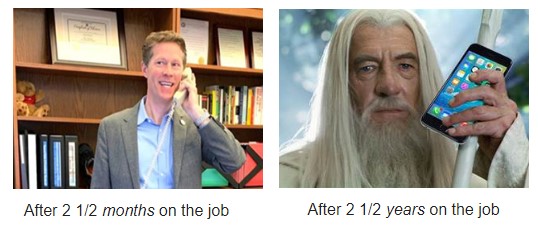 In-person office hours on Friday afternoons are back to Magnuson Park’s Building 30 conference room at 6310 NE 74th Street, Seattle, WA 98115, just a couple of “blocks” into the park’s main entrance. You may continue to sign up through my website or by CLICKING HERE, so I can hear your ideas, concerns, and requests. You can also just send an e-mail to alex.pedersen@seattle.gov.
In-person office hours on Friday afternoons are back to Magnuson Park’s Building 30 conference room at 6310 NE 74th Street, Seattle, WA 98115, just a couple of “blocks” into the park’s main entrance. You may continue to sign up through my website or by CLICKING HERE, so I can hear your ideas, concerns, and requests. You can also just send an e-mail to alex.pedersen@seattle.gov.
For previous e-newsletters, visit my blog by CLICKING HERE.
We are getting through this together, Seattle!
With gratitude,
Councilmember Alex Pedersen
Seattle City Council, District 4
Email: Alex.Pedersen@seattle.gov
Phone: (206) 684-8804
Find It, Fix It
Posted: January 30th, 2023 under Councilmember Pedersen

